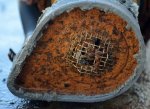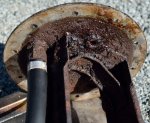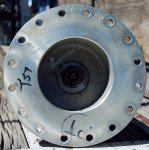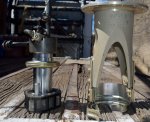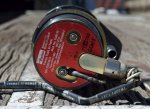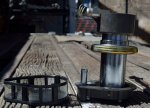Next I have a series of photos here of the inside of my M756A2 fuel tank. The fuel tank is zinc coated, which is good in the case of vegetable oil-petroleum-based fuel blends, because zinc is electrolytically active in chemistry. It is common in chemistry to use zinc as an aid in forcing dissolved solids out of solution.
In the case of vegetable oil-petroleum-based fuel blends, the zinc coating attracts gum and high melting point triglycerides out of solution, and it holds on to them, which makes it useful as a kind of filter, as well as a water-proof coating for the tank.
I have also noticed that when the ambient high temperature drops below 75F, and 50F respectively, high melting point triglycerides will precipitate out of solution and cling to the walls of the tank. Then when the ambient high temperature rises about 25F over the precipitation point, then the high melting point triglyceride will return to solution, and be burned as fuel.
Another good thing about gum accumulating on the surface of a zinc coated fuel tank, is gum is nearly impervious to almost all solvents, especially water, which commonly corrodes zinc coated steel. So, there is at least one other significant advantage to running a deuce on vegetable oil-based fuels.
Above is the bottom of the fuel screen. You can see in this image that the screen is coated with gum. By the way, I noticed that my fuel screen is made of copper, and soldered on. Copper is also electrolytically active in chemistry; however, I tried using it to extract fat, and it does not do so, but it might work for just extracting gum.
Above is the drain plug from my fuel tank. As you can see the inside surface of the plug is coated with gum.
The above photo is of the side of the fuel filler screen. The white crust is most probably very high melting point triglycerides, probably in the 200F range; because the triglycerides with melting points of 165F and below tend to be gummy at ambient temperatures. You can also see gum in this image. It turns out that gum is yellow to amber, and rust-red; whereas, triglycerides are clear to white.
This image above is the inside top of the fuel filler screen. You can see that there is quite a crust of gum around it.
This is the bottom of my deuce fuel tank. This coating is after draining, and flushing the tank out with ULSD diesel fuel.
When I flushed my fuel tank I collected 2qts (liters) of dirt. The dirt was a combination of gravel, sand, silt and clay. It is possible that someone dumped the dirt in, but since this deuce was in military service for about 5 years, before being sold to Cochise County and used for about 40 years in their maintenance yard, and the fuel cap did not seal well, then the dirt might have been due to the rigors of work. Nonetheless I have fabricated a locking mechanism to keep vandals and thieves out of my fuel tank.
The coating is primarily gum which glued particles of sand and dirt into it. The coating makes a really good rust-proof, and fuel-proof, coating.
The above photo is inside the fuel tank, possibly in the section where the fuel pump resides. You can see that the gum coating is fairly uniform and most probably coats the inside of the tank. If you examine the top of the fuel pump in my previous posts on this subject you can see it too is completely coated, so it seems reasonable to consider that the entire inside of the tank is coated with gum.




